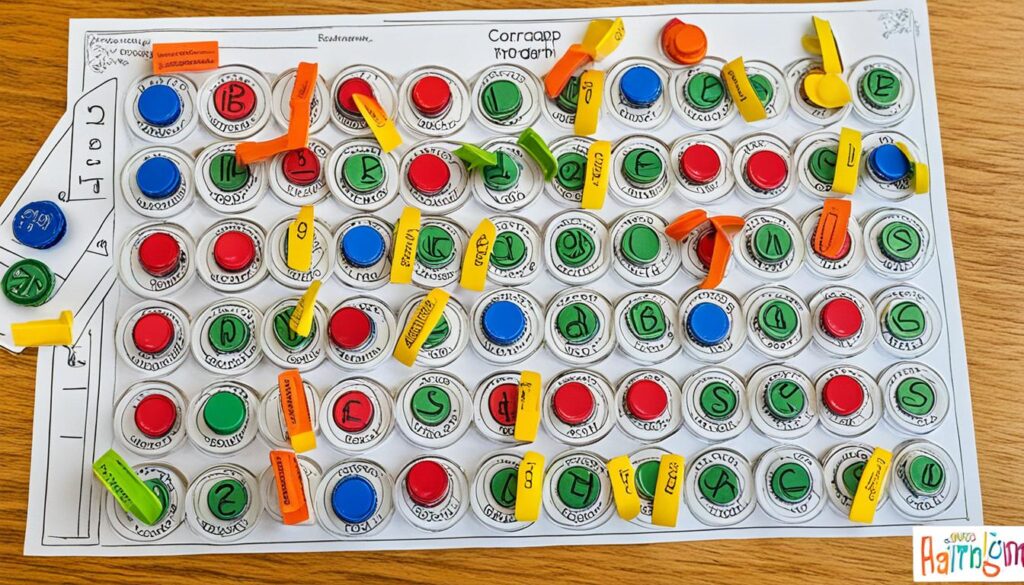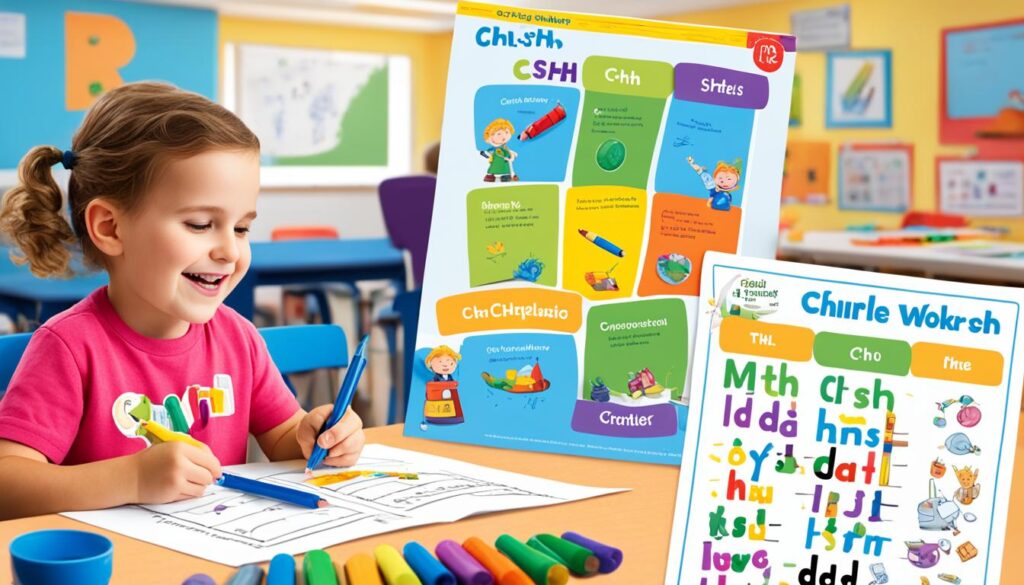Looking for ways to boost your preschoolers’ early reading skills? Digraph activities are not just educational, they’re also interactive and fun. They turn learning into a delightful adventure, setting a strong base for literacy.
But what are digraph activities, exactly? How do they help preschoolers? This article will dive into some creative digraph activities. Your preschoolers will be engaged while they learn crucial reading skills.
Key Takeaways:
- Digraph activities for preschoolers are designed to be fun and engaging, creating an enjoyable learning experience.
- Interactive file folder games are an effective way to introduce and reinforce digraph sounds.
- Hands-on activities using bottle caps provide a tactile learning experience for preschoolers to practice blending sounds.
- Phonics games and activities specifically designed for digraphs promote active engagement and sound blending skills.
- Printable worksheets and centers offer additional independent practice for preschoolers to develop their digraph skills.
Interactive File Folder Games for Digraphs
Interactive file folder games are great for teaching digraph sounds to young kids. They make learning fun and hands-on. By using these games, kids get better at identifying digraphs.
Kids learn to link digraphs with pictures or stories. This helps them understand how two letters can make one sound. It’s key for their early reading skills.
These activities boost phonemic awareness and sound recognition. Kids enjoy learning the difference between “ch,” “sh,” “th,” and “ph.” It’s both fun and educational.
With these games, kids can practice over and over. This helps them learn better and master digraphs. They explore digraphs in varied game settings for a full grasp.
Educators can find printable game templates easily. This makes it simple to make games for specific digraphs. These games fit well into lesson plans or as solo activities.
Hands-on Digraph Activities with Bottle Caps
Using bottle caps for digraph activities is a great way for preschoolers to learn. They get to see and touch the letters, making words with sounds like “ch” and “sh”. This helps preschoolers blend sounds together. They improve their reading skills while having fun.
The “Sort and Match” game is a fun activity with bottle caps. Here’s what you do:
- Collect bottle caps with digraphs like “ch,” “sh,” and “th.”
- Make a sorting mat with three columns for each digraph.
- Give the kids a box of these bottle caps.
- They pick a cap, say its word, and find its digraph group.
- Then, they place the cap in the right column on the mat.
- Keep going until all caps are sorted.
This game helps kids connect sounds to digraphs in a fun way. It helps them think, listen better, and learn how to recognize these sounds.
Another fun bottle cap activity is “Word Building”:
- Give each child different consonants and digraph caps.
- Let them make words with digraphs using the caps.
- They should say the words out loud as they make them.
- For instance, with “s,” “h,” and “ip,” caps, they can create “ship.”
In this activity, kids blend sounds to make words. It boosts their reading skills and makes digraphs easy to remember.
To show why these bottle cap activities are great, here’s a table:
| Benefits of Hands-on Digraph Activities with Bottle Caps | Outcomes |
|---|---|
| 1. Enhanced phonemic awareness | 1. Improved ability to recognize and differentiate between digraphs |
| 2. Development of blending and decoding skills | 2. Increased proficiency in reading and pronouncing words with digraphs |
| 3. Reinforcement of critical thinking and problem-solving | 3. Strengthened cognitive skills in identifying and categorizing digraphs |
| 4. Promotion of fine motor skills | 4. Improved hand-eye coordination and manipulation of small objects |
These bottle cap activities make learning digraphs interactive and fun. Educators can help kids read better, early on, by using them.

Phonics Games and Activities for Digraphs
Phonics games and activities help preschoolers learn digraphs in a fun way. These games focus on digraph recognition and blending sounds. They offer a hands-on way to learn early reading skills.
Playing phonics games lets preschoolers be active in their learning. Whether alone or with friends, these games make learning digraphs fun. They also help children remember what they learn.
One fun game is the “Digraph Treasure Hunt.” Kids look for things with certain digraphs. This game helps with word recognition and grows their vocabulary as they name their finds.
“Digraph Bingo” is another great game. Preschoolers match sounds to pictures on their bingo cards. This helps them recognize digraphs and connect sounds to letters.
The “Digraph Fishing” game is both fun and hands-on. Kids use magnetic rods to catch fish with digraphs on them. This game is good for blending sounds and helps with fine motor skills.
Using different phonics games is key. This way, all kids can join in and learn in a way that’s best for them. It makes learning diverse and fun for everyone.
By making learning phonics interactive, preschoolers build strong reading basics. They learn digraphs and blending sounds well. This prepares them for success in reading.
Printable Digraph Worksheets and Centres
Printable digraph worksheets and centres are great for extra practice. They make learning digraphs fun for preschoolers. These resources help kids develop their digraph skills in a personal and engaging way.
These materials meet different needs, making it easier for each child to learn. They work well for beginners and for those who need more challenge. This way, learning fits each student’s pace.
The activities help with several skills. They focus on recognizing and using digraphs in various ways. These include:
- Word sorting: Kids sort words by their digraphs. This builds their phonological awareness and understanding of digraph sounds.
- Word building: Children create words with letters and digraphs. This boosts phonics skills and word construction.
- Writing exercises: Kids practice writing words with digraphs. These exercises improve spelling and link letters to sounds.
Using these worksheets and centers makes teaching digraphs structured. They can be part of daily lessons or used in literacy stations for extra practice.
Below is a sample word sorting worksheet:

| WORDS WITH DIGRAPHS | DIGRAPH |
|---|---|
| ship | /sh/ |
| fish | /sh/ |
| cat | /c/ |
| chat | /ch/ |
| song | /s/ |
| sing | /s/ |
This word sorting worksheet helps kids learn about the “sh” digraph. Organizing words this way helps them understand how digraphs change word sounds.
Printable digraph worksheets and centers are great tools. They improve kids’ skills with digraphs, making learning enjoyable and rewarding.
Using Picture Support for Teaching Digraphs
Integrating pictures with words helps preschoolers learn digraphs easily. They can link digraph sounds to specific pictures. This makes learning fun and effective.
Teachers have various tools like flashcards, posters, or digital resources. These tools have clear pictures representing words with digraphs. For “sh,” use images of a shell or shark to highlight the sound.
Using pictures helps kids connect letters and their sounds. This approach turns abstract ideas into something they can understand. It makes learning more exciting.
Also, mixing picture support with phonics games boosts learning. Creating games where kids match pictures with digraph words sharpens their thinking. It also improves their problem-solving abilities.
Including digraph picture books in class or storytime is beneficial. These books have captivating illustrations focusing on digraphs. Reading these books out loud betters their listening skills and digraph knowledge.
Example of Digraph Picture Support Activity:
An awesome activity is a “Digraph Hunt” scavenger hunt. It’s fun and teaches effectively.
- Make a list of words with different digraphs, like “ship,” “math,” “chop,” “thumb,” “clap,” and “catch.”
- Print or show pictures of things each word describes.
- Hide these pictures in the classroom or outside.
- Give kids a checklist of the digraphs. They must find the matching pictures.
- When they find a picture, they should say the word and the digraph out loud.
- Afterward, talk about the digraphs as a group to reinforce learning.
This activity merges seeing and doing. It boosts active learning and language skills.
With picture support in digraph lessons, kids learn better visually. This method mixes visuals and activities for a fun learning experience. It helps kids of all learning styles and makes education enjoyable.
Adding pictures to digraph lessons aids understanding and memory. It guarantees that young learners can use digraphs confidently in reading and writing.
Incorporating Digraph Activities in Literacy Stations
Teaching preschoolers digraphs at literacy stations can be both effective and fun. Literacy stations offer a structured way for kids to learn by doing. They can practice digraphs through various activities and games, making phonics skills fun to learn.
In these stations, kids get to explore phonics concepts like digraph recognition and sound blending. Each area of the classroom can focus on a different digraph or skill. For example, one station might teach the “sh” sound, while another works on blending digraphs with consonants.
At each station, preschoolers get to try out fun hands-on activities and games. These engage them and promote learning. Activities might include:
- Matching games: Children find pairs that share the same digraph sound.
- Sorting activities: Kids categorize cards or objects by the digraph sounds they hear.
- Word-building games: Preschoolers create words using letters that contain digraphs.
- Reading stations: Children read books rich in specific digraphs, enhancing their skills.
Literacy stations offer a comprehensive way to teach digraphs, allowing children to practice in various forms. This method boosts phonics skills and helps with overall literacy growth.
| Activity | Description |
|---|---|
| Matching Game | Kids match pictures to words with the “ch” digraph, like “chair” or “cheese”. |
| Word Sort | Preschoolers divide cards into those starting with “ch” and those ending with it. |
| Building Words | Using letters, kids make and read words that have the “ch” digraph. |
| Reading Corner | Children discover books featuring “ch” digraph words, practicing their reading. |
Adding digraph activities to literacy stations offers a great learning experience. These activities improve digraph recognition, sound blending, and phonics skills. This approach doesn’t just make learning enjoyable. It also builds a strong foundation for early reading skills.
Making Learning Fun with Digraph Games and Puzzles
Digraph games and puzzles turn learning into fun for preschoolers. These tools use games and puzzles to help learn. They make understanding digraphs easier and more enjoyable.
Digraph games are a hit for hands-on learning. Children love playing snap games where they match cards with digraph pictures. This helps them know and use digraphs while boosting their word skills.
Puzzles add more fun to learning digraphs. Working on jigsaw puzzles, kids improve problem-solving and learn about digraphs. They get better at seeing how digraphs fit into words.
Games and puzzles make learning exciting. They help preschoolers practice digraphs in a fun way. This sparks a love for learning and prepares them for reading and talking well in the future.

